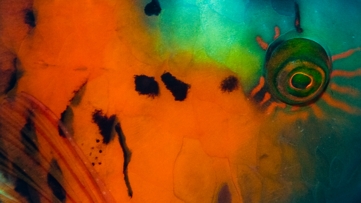
| Home |
| Colors of the Reef |
| Search the Reef |
| Science and the Reef |
| Equipment |
| New |
| Links |
| Contact |
| Interna |
Focus Lights
Focus lights are essential for macro photography under dim light conditions. The requirements for focus lights are quite different from that of standard dive lights. The beam should be wide to avoid hot-spots. A wide beam also makes it unnecessary to re-adjust the focus light all the time. Since the focus light is mounted at the camera housing or arm system, it should be compact and lightweight. The light should be dimmable to adjust to various lighting conditions, and show a color temperature close to that of the strobes (again to avoid hot spots). A red filter or red LEDs are convenient not to scare off sensitive critter. An additional bonus would be to use standard AA batteries instead of build-in batteries that need to be charged with a dedicated charger. AA batteries can be exchanged within seconds at the dive site, whereas recharging batteries takes hours and requires access to a power line.
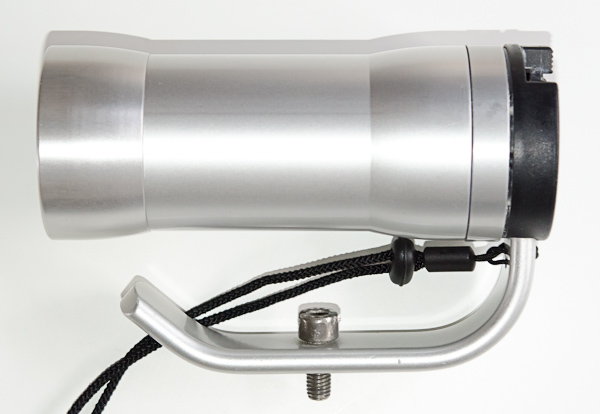 Hartenberger Nano. A very useful general dive lamp that can be easily converted to a focus light is the Hartenberger Nano Compact. This small lamp is almost perfect for most purposes. The spot reflector in combination with a 20 W HLX bulb using controlled 125% over-voltage is bright enough for night dives in any muddy lake, burn time at 100% voltage is about one hour (lithium manganese rechargeable battery). The light can be dimmed in four steps, which is great for night dives in clear water, where full power is far too bright. The lamp is controlled by a microprocessor and the status (brightness and remaining power) shown at the back of the lamp by small LEDs.
Hartenberger Nano. A very useful general dive lamp that can be easily converted to a focus light is the Hartenberger Nano Compact. This small lamp is almost perfect for most purposes. The spot reflector in combination with a 20 W HLX bulb using controlled 125% over-voltage is bright enough for night dives in any muddy lake, burn time at 100% voltage is about one hour (lithium manganese rechargeable battery). The light can be dimmed in four steps, which is great for night dives in clear water, where full power is far too bright. The lamp is controlled by a microprocessor and the status (brightness and remaining power) shown at the back of the lamp by small LEDs.
To use as focus light, the spot reflector module is exchanged by the optional flood reflector. This produces a very smooth and wide beam to avoid hot spots in the pictures. I also like the slightly more red color of HLX lamps compared to LEDs and Xenon lamps, the color temperature is approximately 3600 K. Of course, it looks less bright, but it has more of the color we are missing most underwater: red. The HLX module can be exchanged by an LED-module with red-light compensation, however at the moment (January 2012) only as spot module. Disadvantage of this lamp is the high price and the weight of 670 g.
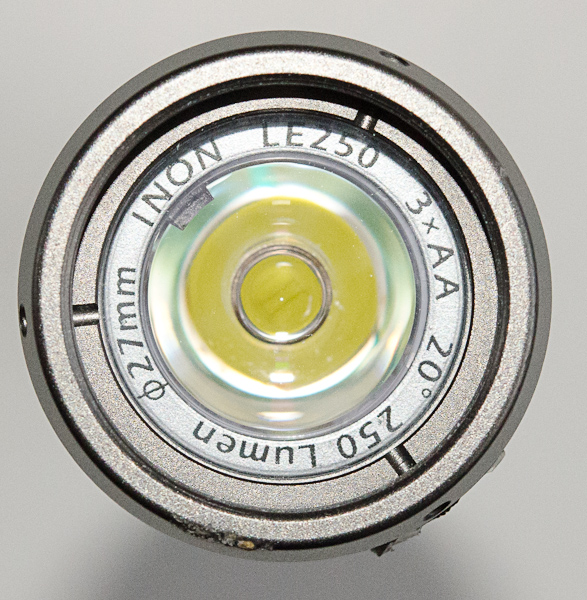
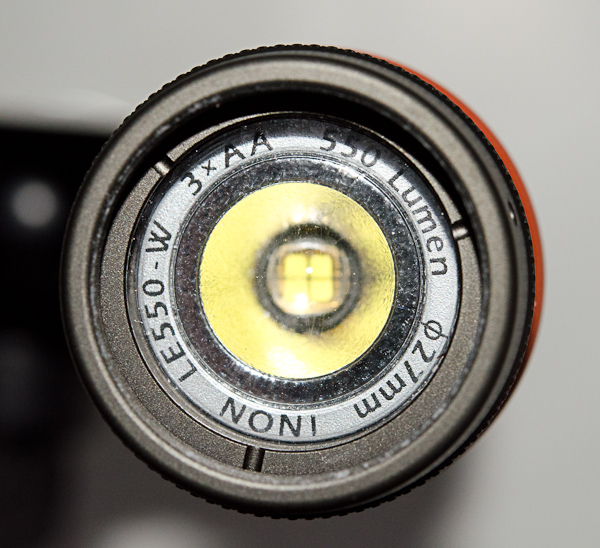 Inon LED. The Inon LED lights are very robust, simple, and lightweight. I am using the older LE250 and the twice as bright LE550-W. The specification of the LE250 is 250 lumen output and 20° coverage (40° with a white filter attached), and that of the LE550-W 550 Lumen and 75° coverage. If both light are used together, the intensity and beam characteristics can be controlled to a certain degree by switching each or both lights on or off.
Inon LED. The Inon LED lights are very robust, simple, and lightweight. I am using the older LE250 and the twice as bright LE550-W. The specification of the LE250 is 250 lumen output and 20° coverage (40° with a white filter attached), and that of the LE550-W 550 Lumen and 75° coverage. If both light are used together, the intensity and beam characteristics can be controlled to a certain degree by switching each or both lights on or off.
Three standard AA batteries are used, which allow continuous operation of more than one hour, depending on the batteries. I use rechargeable Eneloop batteries which are recommended by Inon. A big advantage is that the Z-240 strobe uses the same batteries, and no extra charger has to be carried.
The light output is not stabilized by a microprocessor, which means that the beam intensity is gradually decreasing, as the voltage of the batteries is decreasing during burn-time. This is a disadvantage compared to the Hartenberger Nano, where the beam intensity is constant. However, this also means that the Hartenberger Nano switches off completely once the voltage of the batteries drops below a certain threshold (to prevent damage of the batteries), whereas the Inon lights still produce some light at the end of a long dive.
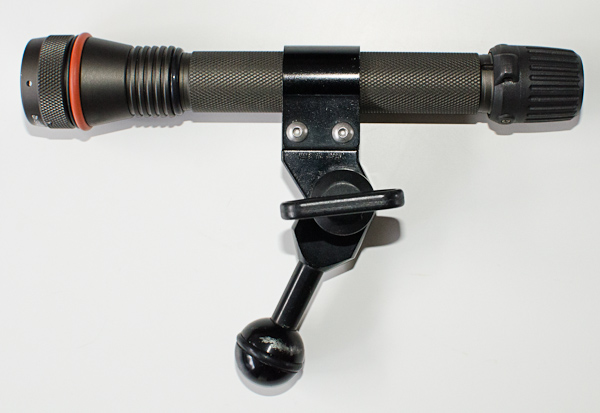 The color temperature of the INON lights is about 6000 K, as usual for white LEDs. The disadvantage of the high color temperature as a dive and video light is not only the bluish look of the beam, but also the unbalanced spectral characteristics if compared with sunlight. This results in "unnaturally" looking colors, whatever this means underwater. As focus light, on the other hand, this is not a disadvantage, since here it is only important that the camera can focus on whatever you spot. The color and characteristics of the beam can be changed by various filters that come with the lights. Useful is the red-filter which allows the camera to focus while being less disturbing to animals, and the white filter, which produce an even wider and more even beam. I am not sure why someone should use the pink filter.
The color temperature of the INON lights is about 6000 K, as usual for white LEDs. The disadvantage of the high color temperature as a dive and video light is not only the bluish look of the beam, but also the unbalanced spectral characteristics if compared with sunlight. This results in "unnaturally" looking colors, whatever this means underwater. As focus light, on the other hand, this is not a disadvantage, since here it is only important that the camera can focus on whatever you spot. The color and characteristics of the beam can be changed by various filters that come with the lights. Useful is the red-filter which allows the camera to focus while being less disturbing to animals, and the white filter, which produce an even wider and more even beam. I am not sure why someone should use the pink filter.
The LE550-W is a very capable focus light, which will replace my Hartenberger Nano. The Inon lights are longer (20 cm) than the Hartenberger Nano (15 cm), but the diameter is only 3.3 cm (Inon), compared to 6 cm (Hartenberger). And the weight of the Inon lights is with 220 g (including batteries) only 1/3 of that of the Hartenberger Nano.

